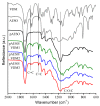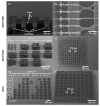Photoinitiator Free Resins Composed of Plant-Derived Monomers for the Optical µ-3D Printing of Thermosets
- PMID: 30960100
- PMCID: PMC6401862
- DOI: 10.3390/polym11010116
Photoinitiator Free Resins Composed of Plant-Derived Monomers for the Optical µ-3D Printing of Thermosets
Abstract
In this study, acrylated epoxidized soybean oil (AESO) and mixtures of AESO and vanillin dimethacrylate (VDM) or vanillin diacrylate (VDA) were investigated as photosensitive resins for optical 3D printing without any photoinitiator and solvent. The study of photocross-linking kinetics by real-time photorheometry revealed the higher rate of photocross-linking of pure AESO than that of AESO with VDM or VDA. Through the higher yield of the insoluble fraction, better thermal and mechanical properties were obtained for the pure AESO polymer. Here, for the first time, we validate that pure AESO and mixtures of AESO and VDM can be used for 3D microstructuring by employing direct laser writing lithography technique. The smallest achieved spatial features are 1 µm with a throughput in 6900 voxels per second is obtained. The plant-derived resins were laser polymerized using ultrashort pulses by multiphoton absorption and avalanche induced cross-linking without the usage of any photoinitiator. This advances the light-based additive manufacturing towards the 3D processing of pure cross-linkable renewable materials.
Keywords: acrylated epoxidized soybean oil; direct laser writing; multi-photon processing; nanolithography; optical 3D printing; photocross-linking; two-photon polymerization (2PP); vanillin diacrylate; vanillin dimethacrylate.
Conflict of interest statement
The authors declare no conflict of interest.
Figures








Similar articles
-
Vegetable Oil-Based Thiol-Ene/Thiol-Epoxy Resins for Laser Direct Writing 3D Micro-/Nano-Lithography.Polymers (Basel). 2021 Mar 12;13(6):872. doi: 10.3390/polym13060872. Polymers (Basel). 2021. PMID: 33809044 Free PMC article.
-
Vanillin Acrylate-Based Resins for Optical 3D Printing.Polymers (Basel). 2020 Feb 10;12(2):397. doi: 10.3390/polym12020397. Polymers (Basel). 2020. PMID: 32050639 Free PMC article.
-
Improving the 3D Printability and Mechanical Performance of Biorenewable Soybean Oil-Based Photocurable Resins.Polymers (Basel). 2024 Apr 3;16(7):977. doi: 10.3390/polym16070977. Polymers (Basel). 2024. PMID: 38611235 Free PMC article.
-
Photopolymerizable Resins for 3D-Printing Solid-Cured Tissue Engineered Implants.Curr Drug Targets. 2019;20(8):823-838. doi: 10.2174/1389450120666190114122815. Curr Drug Targets. 2019. PMID: 30648506 Review.
-
Multiphoton Laser Fabrication of Hybrid Photo-Activable Biomaterials.Sensors (Basel). 2021 Sep 1;21(17):5891. doi: 10.3390/s21175891. Sensors (Basel). 2021. PMID: 34502787 Free PMC article. Review.
Cited by
-
UV-Light Curing of 3D Printing Inks from Vegetable Oils for Stereolithography.Polymers (Basel). 2021 Apr 7;13(8):1195. doi: 10.3390/polym13081195. Polymers (Basel). 2021. PMID: 33917193 Free PMC article.
-
Vegetable Oil-Based Thiol-Ene/Thiol-Epoxy Resins for Laser Direct Writing 3D Micro-/Nano-Lithography.Polymers (Basel). 2021 Mar 12;13(6):872. doi: 10.3390/polym13060872. Polymers (Basel). 2021. PMID: 33809044 Free PMC article.
-
UV-Cured Bio-Based Acrylated Soybean Oil Scaffold Reinforced with Bioactive Glasses.Polymers (Basel). 2023 Oct 14;15(20):4089. doi: 10.3390/polym15204089. Polymers (Basel). 2023. PMID: 37896333 Free PMC article.
-
Biobased Composites from Eugenol- and Coumarin-Derived Methacrylic Latex and Hemp Nanocellulose: Cross-Linking via [2 + 2] Photocycloaddition and Barrier Properties.ACS Sustain Chem Eng. 2024 May 30;12(23):8741-8751. doi: 10.1021/acssuschemeng.4c01365. eCollection 2024 Jun 10. ACS Sustain Chem Eng. 2024. PMID: 39534019 Free PMC article.
-
Urethane dimethacrylate-based photopolymerizable resins for stereolithography 3D printing: A physicochemical characterisation and biocompatibility evaluation.Drug Deliv Transl Res. 2024 Jan;14(1):177-190. doi: 10.1007/s13346-023-01391-y. Epub 2023 Jul 15. Drug Deliv Transl Res. 2024. PMID: 37454029 Free PMC article.
References
-
- Corbel S., Dufaud O., Roques-Carmes T. Stereolithography. Springer; Boston, MA, USA: 2011. Materials for stereolithography; pp. 141–159.
-
- Skliutas E., Kasetaite S., Jonušauskas L., Ostrauskaite J., Malinauskas M. Photosensitive Naturally Derived Resins toward Optical 3-D Printing. Opt. Eng. 2018;57:041412. doi: 10.1117/1.OE.57.4.041412. - DOI
-
- Ligon-Auer S.C., Schwentenwein M., Gorsche C., Stampfl J., Liska R. Toughening of Photo-Curable Polymer Networks: A Review. Polym. Chem. 2016;7:257–286. doi: 10.1039/C5PY01631B. - DOI
Grants and funding
LinkOut - more resources
Full Text Sources

